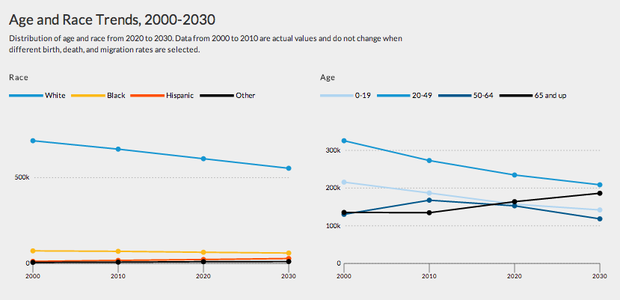We can already see that the population is aging and becoming more diverse, but how will those trends play out at the local and regional levels? See what your city will look like in 15 years with Urban Institute's new interactive tool.
We can already see that the population is aging and becoming more diverse, but how will those trends play out at the local and regional levels? And what if, in the future, we live longer or have more babies? How would those trends affect the population in different cities and states? Urban Institute's new interactive tool explores the possibilities.
The new interactive tool was ultimately developed with urban planners and civic leaders in mind, but offers a fascinating glimpse into what the future could look like. Examining migration, race and age, the "Mapping America's Future" tool allows users to see these metrics based on low, average and accelerated rates of growth. The tool allows users to pick low, average, or high rates for birth, death and migration—the three drivers of population change—and the map changes in response.
The rates are all reasonable assumptions, based on historical trends. In other words, it won’t show a future where no children are born and no one dies, but we could imagine a future where people move around more or birthrates fall by 20 percent. With the tool, people can explore several possible “what-if” scenarios—possible futures—and see how they’ll play out across the country.
A future with more births and longer lives looks very different from one with fewer births and high mortality. And migration—one of the most difficult forces to predict—can change areas rapidly, not just in sheer numbers, but also in terms of an area’s racial and ethnic makeup, its workers and tax base, its demand for housing and for government services, and, arguably, its character, according to the Urban Insititute.
The tool also shows that the minority populations will surpass the aging, white majority by 2042. New births, immigration, and internal migration will reconfigure the populations of our cities, towns and suburbs.




